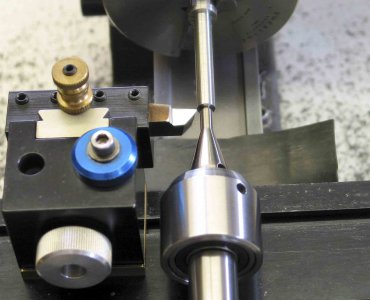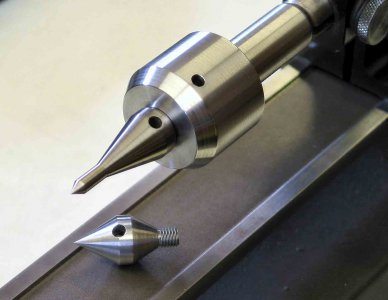- Joined
- Jan 21, 2015
- Messages
- 67
I have been trying for weeks to make a steel screw. I'm trying for one about 6mm long and with about a 1mm shaft. I am using O2 drill rod for the screws, and I can easily cut the profile and even the thread relief. But when it comes to the threading, no luck so far. I've been filling a little box with my ruined attempts.
My lathe uses handwheels for threading (no motor), and I use a 4x jeweler's loupe as I thread, so I have excellent control over the process. I just don't know what the heck I'm doing.
I started with a 60 deg. carbide tool, but the tip of that tool shattered within the first 5 mm of cutting. But I don't want to use carbide, I'd rather use steel.
The tools I've ground so far are from 1/4" HSS blanks. On the first one, the tip became rounded off on the first pass (about 3mm) after taking a 0.04mm cut. I ground a new one, then tried to harden it by bringing it to cherry red, then quenching it in black oil. Then I tried taking only 0.02mm cuts (just dusting). The tip of the tool crushed down, with the very tip (just the last 0.01mm) slipping down off the edge--ruined!
Made yet another tool. The screw simply bent out of the way of the tool, which cut nothing. Each subsequent pass just pushed the screw further out of the way until it bent and was ruined.
What's the secret of cutting a tiny steel screw with steel? I know the old timers were able to cut steel--they weren't using carbide in the 1880's. How did they do it?
My lathe uses handwheels for threading (no motor), and I use a 4x jeweler's loupe as I thread, so I have excellent control over the process. I just don't know what the heck I'm doing.
I started with a 60 deg. carbide tool, but the tip of that tool shattered within the first 5 mm of cutting. But I don't want to use carbide, I'd rather use steel.
The tools I've ground so far are from 1/4" HSS blanks. On the first one, the tip became rounded off on the first pass (about 3mm) after taking a 0.04mm cut. I ground a new one, then tried to harden it by bringing it to cherry red, then quenching it in black oil. Then I tried taking only 0.02mm cuts (just dusting). The tip of the tool crushed down, with the very tip (just the last 0.01mm) slipping down off the edge--ruined!
Made yet another tool. The screw simply bent out of the way of the tool, which cut nothing. Each subsequent pass just pushed the screw further out of the way until it bent and was ruined.
What's the secret of cutting a tiny steel screw with steel? I know the old timers were able to cut steel--they weren't using carbide in the 1880's. How did they do it?



